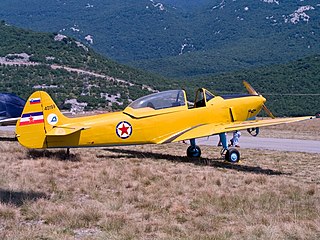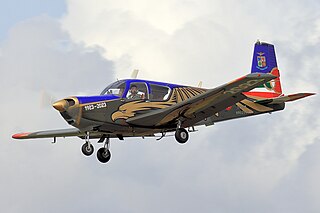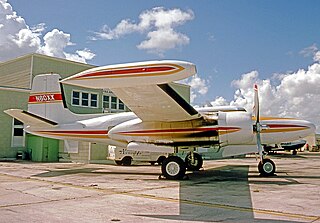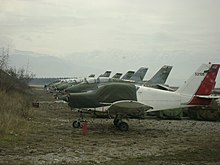
The CASA C-101 Aviojet is a low-wing single engine jet-powered advanced trainer and light attack aircraft designed and manufactured by Spanish aircraft company Construcciones Aeronáuticas SA (CASA).

The UTVA Aero 3 was a piston-engined military trainer aircraft built in Yugoslavia to replace the Ikarus Aero 2 then in service. One hundred ten were built, in Yugoslav Air Force service from 1958 to mid-1970s. It was superseded by the UTVA 75.

The Yakovlev Yak-18T is a four- or five-seat fully aerobatic utility aircraft developed by Yakovlev. Introduced to train Aeroflot pilots, it has gained some popularity as a sportplane both inside and outside the former USSR. It is powered by a 268-298 kW (360-400 hp) Vedeneyev M14P radial engine, and is designed for stresses of +6.48/-3.24 g.

The Soko G-4 Super Galeb, also referred to as N-62, is a Yugoslav single-engine, advanced jet trainer and light ground-attack aircraft designed by the Aeronautical Technical Institute at Žarkovo and manufactured by the SOKO aircraft factory in Mostar.

The Grob G 120 is a two-seat training and aerobatic low-wing aircraft with a carbon composite airframe, built by Grob Aircraft. It is based on the Grob G 115TA training aircraft and is specially designed for military and civil pilots training. It has a tricycle landing gear and a low tailplane.

The Soko J-20 Kraguj is a light military, single-engine, low-wing single-seat aircraft with a metal airframe, capable of performing close air support, counterinsurgency (COIN), and reconnaissance missions, that was designed by VTI and manufactured by SOKO of Yugoslavia, first flown in 1962.

The Sukhoi Su-15 was a prototype Soviet all-weather interceptor which never reached production.

ENAER T-35 Pillán is a Chilean propeller-driven basic trainer aircraft. The student and the instructor sit in tandem. Production ceased in 1991 after 7 years but restarted briefly in 1998.

The Soko J-21 Jastreb, referred to as the J-1 Jastreb in some sources, is a Yugoslav single-seat, single-engine, light attack aircraft, designed by the Aeronautical Technical Institute (ATI) and Vojnotehnički Institut Beograd (VTI), in Belgrade and manufactured by SOKO in Mostar. Derived from the G-2 Galeb advanced jet trainer and light attack aircraft, it was designed in single-seat ground-attack and two-seat advanced flying/weapon training versions.

The SIAI-Marchetti S.205 is an Italian four-seat, single-engine, light airplane, manufactured by SIAI-Marchetti. The S.205 made its maiden flight in 1965. The Italian Air Force employs a version called S.208.

The Zlín Z-XII was a Czechoslovak two-seat sports aircraft, and the first major design success by the Zlínská Letecká Akciová Společnost (Zlín) aircraft manufacturing company, after its founding in Otrokovice after the takeover by the Bata Group.

The On Mark Marksman was an American high-speed civil executive aircraft converted from surplus Douglas A-26 Invader airframes by On Mark Engineering. Its antecedents were the On Mark Executive and the On Mark Marketeer.

The NAC Fieldmaster was a British agricultural aircraft of the 1980s. A turboprop powered single-engined monoplane, it was built in small numbers and used both as a cropsprayer and a firefighting aircraft.

The Utva Lasta 95 is a light military trainer aircraft produced by Utva Aviation Industry, subsidiary of Yugoimport SDPR. It is a tandem two-seater low-wing trainer with a metal airframe. The aircraft is capable of basic training functions including aerobatics, instrument and tactical flying, as well as basic training in use of weapons. The first prototype of Lasta 1 flew on 2 September 1985, while the first prototype of the current version, Lasta 3, flew on February 26, 2009. Lasta is the Serbian word for barn swallow.

The UTVA-66 is a STOL aircraft, which was produced in the former Yugoslavia. It was developed from the UTVA-60 and first flew 1966.

The Utva-65 Privrednik (Merchant) is a Yugoslav civil aircraft designed and used for agricultural work.
The UTVA-60 is a Yugoslavian light aircraft of the 1960s. First flying in 1959, it was built by UTVA for both the Yugoslavian armed forces and for civilian use.

The UTVA Kobac was a prototype Serbian single-engine, low-wing tandem-seat turboprop training/light attack aircraft manufactured by Pančevo based UTVA Aviation Industry, and designed by the Military Technical Institute. Revealed as a mockup on 2 September 2012 during the Batajnica 2012 Air Show, the aircraft's first flight was planned for 2013, but was never realized.
The Jingmen A2C Ultra Seaplane is a Chinese three-seat ultralight aircraft that was designed by the China Avionics Research Institute and produced by Jingmen Aviation of Jingmen, introduced in 2003.

The Tecnam P-Mentor is an Italian light aircraft, intended for flight training, designed and produced by Tecnam of Casoria. It was introduced in April 2022 and is EASA CS-23 type certified in Europe.

























